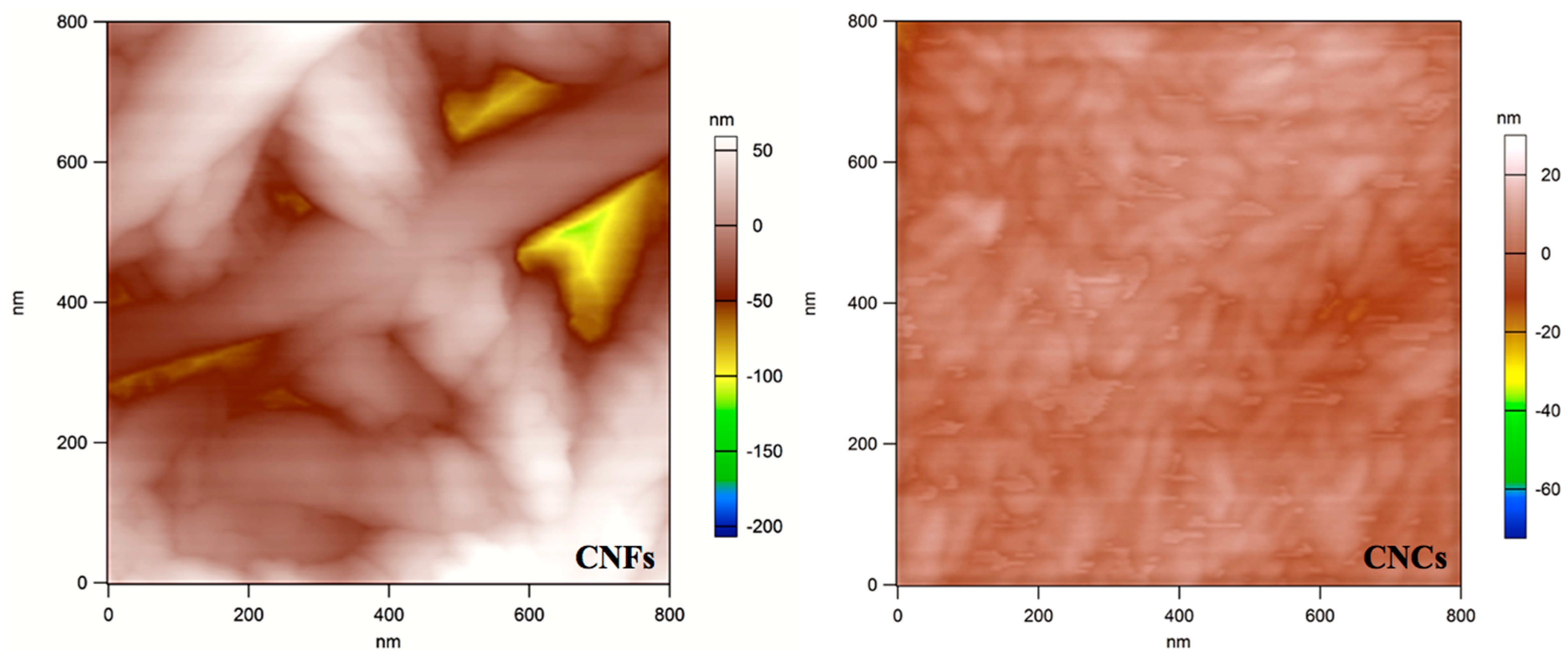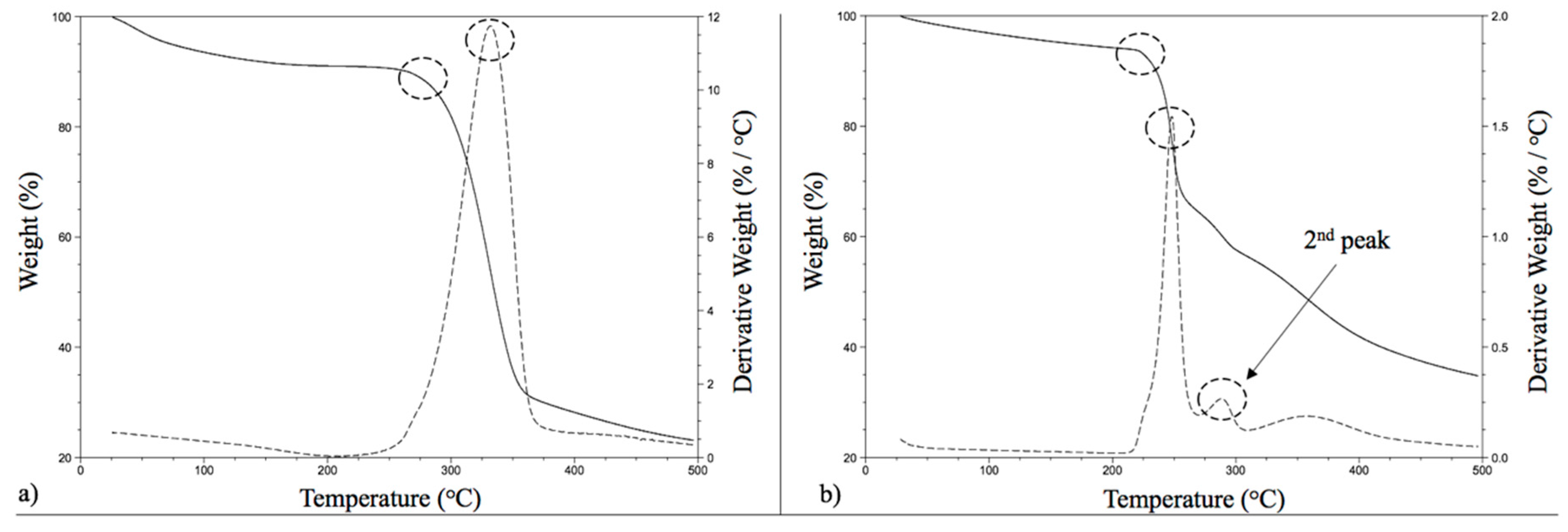A Study on Thermal and Nanomechanical Performance of Cellulose Nanomaterials (CNs)
Abstract
:1. Introduction
2. Materials and Methods
Sample Preparation
3. Morphology
4. Nanoindentation
4.1. Oliver Pharr (OP) Approach
4.2. Fused Silica (FS) Approach
4.3. Nanoindentation on CNs
5. Thermal Stability
6. Statistical Analysis
7. Results and Discussion
7.1. Morphological Properties of CNF and CNC
7.2. Nanoindentations—Fused Silica
7.3. The Comparison of OP and FS Approaches Using CNF and CNC
7.3.1. Nanoindentations—CNF
7.3.2. Nanoindentations—CNC
7.4. The Comparison of Nanomechanical Performance of CNF and CNC through OP and FS Approaches
7.5. The Comparison of Thermal Stability Performance of CNF and CNC
8. Conclusions
Acknowledgments
Author Contributions
Conflicts of Interest
References
- Osong, S.H.; Norgren, S.; Engstrand, P. Processing of wood-based microfibrillated cellulose and nanofibrillated cellulose, and applications relating to papermaking: A review. Cellulose 2016, 23, 93–123. [Google Scholar] [CrossRef]
- Moon, R.J.; Martini, A.; Nairn, J.; Simonsen, J.; Youngblood, J. Cellulose nanomaterials review: Structure, properties and nanocomposites. Chem. Soc. Rev. 2010, 40, 3941–3944. [Google Scholar] [CrossRef] [PubMed]
- Cai, Z.; Rudie, A.W.; Stark, N.M.; Sabo, R.C.; Ralph, S.A. Chapter 6: New products and product categorie. In The Global Forest Sector: Changes, Practices and Prospects; Hansen, E., Panwar, R., Vlosky, R., Eds.; CRC Press: Boca Raton, FL, USA, 2013; pp. 129–149. [Google Scholar]
- Arvidsson, R.; Nguyen, D.; Svanstrom, M. Life cycle assessment of cellulose nanofibrils productions by mechanical treatment and two different pretreatment processes. Environ. Sci. Technol. 2015, 49, 6881–6890. [Google Scholar] [CrossRef] [PubMed]
- Krishnamachari, P.; Hashaikeh, R.; Chiesa, M.; Gad El Rab, K.R.M. Effects of acid hydrolysis time on cellulose nanocrystals properties: Nanoindentation and thermogravimetric studies. Cellul. Chem. Technol. 2011, 46, 13–18. [Google Scholar]
- Ago, M.; Jakes, J.E.; Rojas, O.J. Thermomechanical properties of lignin-based electrospun nanofibers and films reinforced with cellulose nanocrystals: A dynamic mechanical and nanoindentation study. Appl. Mater. Interfaces 2013, 5, 11768–11776. [Google Scholar] [CrossRef] [PubMed]
- Pakzad, A.; Simonse, J.; Heiden, P.A.; Yassar, R.S. Size effects on the nanomechanical properties of cellulose I nanocrystals. J. Mater. Res. 2011, 27, 528–536. [Google Scholar] [CrossRef]
- Abraham, E.; Deepa, B.; Pothan, L.A.; Jacob, M.; Thomas, S.; Cvelbar, U.; Anandjiwala, R. Extraction of nanocellulose fibrils from lignocellulosic fibres: A novel approach. Carbohydr. Polym. 2011, 86, 1468–1475. [Google Scholar] [CrossRef]
- Oliver, W.C.; Pharr, G.M. An improved technique for determining hardness and elastic modulus using load and displacement sensing indentation experiments. J. Mater. Res. 1992, 7, 1564–1583. [Google Scholar] [CrossRef]
- Hay, J.; Crawford, B. Measuring substrate-independent modulus of thin films. J. Mater. Res. 2011, 26, 727–738. [Google Scholar] [CrossRef]
- Roberts, R.J.; Rowe, R.C.; York, P. The Poisson’s ratio of microcrystalline cellulose. Int. J. Pharm. 1994, 105, 177–180. [Google Scholar] [CrossRef]
- Nakamura, K.; Wada, M.; Kuga, S.; Okano, T. Poisson’s ratio of cellulose Iβ and cellulose II. J. Polym. Sci. Part B Polym. Phys. 2004, 42, 1206–1211. [Google Scholar] [CrossRef]
- Yildirim, N.; Shaler, S.M. Nanomechanical properties of cellulose nanofibrils (CNF). MRS Adv. 2016, 1, 639–644. [Google Scholar] [CrossRef]
- Yildirim, N.; Shaler, S.M. The application of nanoindentation for determination of cellulose nanofibrils’ (CNF) nanomechanical properties. Mater. Res. Express 2016, 3. [Google Scholar] [CrossRef]
- Kaboorani, A.; Riedl, B.; Blanchet, P.; Fellin, M.; Hosseinaei, O.; Wang, S. Nanocrystalline cellulose (NCC): a renewable nano-material for polyvinyl acetate (PVA) adhesive. Eur Polym. J. 2012, 48, 1829–1837. [Google Scholar] [CrossRef]
- Das, K.; Ray, D.; Bandyopadhyay, N.R.; Sengupta, S. Study of the properties of microcrystalline cellulose particles from different renewable resources by XRD, FTIR, nanoindentation, TGA and SEM. J. Polym. Environ. 2010, 18, 355–363. [Google Scholar] [CrossRef]
- Wagner, R.; Moon, R.J.; Raman, A. Mechanical properties of cellulose nanomaterials studied by contact resonance atomic force microscopy. Cellulose 2016, 23, 1031–1041. [Google Scholar] [CrossRef]
- Josefsson, G.; Tanem, B.S.; Li, Y.; Vullum, P.E.; Gamstedt, E.K. Prediction of elastic properties of nanofibrillated cellulose from micromechanical modeling and nano-structure characterization by transmission electron microscopy. Cellulose 2013, 20, 761–770. [Google Scholar] [CrossRef]
- Hoeger, I.; Rojas, O.J.; Efimenko, K.; Velev, O.D.; Kelley, S.S. Ultrathin film coatings of aligned cellulose nanocrystals from a convective-shear assembly system and their surface mechanical properties. Soft Matter 2011, 7, 1957–1967. [Google Scholar] [CrossRef]
- Dong, H.; Strawhecker, K.E.; Snyder, J.F.; Orlicki, J.A.; Reiner, R.S.; Rudie, A.W. Cellulose nanocrystals as a reinforcing material for electrospun poly (methyl methacrylate) fibers: Formation, properties and nanomechanical characterization. Carbohydr. Polym. 2012, 87, 2488–2495. [Google Scholar] [CrossRef]
- Wang, N.; Ding, E.; Cheng, R. Thermal degradation behaviors of spherical cellulose nanocrystals with sulfate groups. Polymer 2007, 48, 3486–3493. [Google Scholar] [CrossRef]
- Kargarzadeh, H.; Ahmad, I.; Abdullah, I.; Dufresne, A.; Zainudin, S.Y.; Sheltami, R.M. Effects of hydrolysis conditions on the morphology, crystallinity, and thermal stability of cellulose nanocrystals extracted from kenaf bast fibers. Cellulose 2012, 19, 855–866. [Google Scholar] [CrossRef]
- Schniewind, A.P. Concise Encyclopedia of Wood and Wood Based Materials, 1st ed.; Pergamon Press: Oxford, UK, 1989; ISBN 9780080347264. [Google Scholar]
- Herrera, M.A.; Mathew, A.P.; Oksman, K. Characterization of cellulose nanowhiskers: A comparison of two industrial bio-residues. Mater. Sci. Eng. 2012, 31. [Google Scholar] [CrossRef]
- Lu, P.; Hsieh, Y.L. Preperation and properties of cellulose nanocrystals: Rods, spheres, and network. Carbohydr. Polym. 2010, 82, 329–336. [Google Scholar] [CrossRef]
- Fortunati, E.; Armentano, I.; Zhou, Q.; Iannoni, A.; Saino, E.; Visai, L.; Berglund, L.A.; Kenny, J.M. Multifunctional bionancomposite films of poly(lactic acid), cellulose nanocrystal and silver nanoparticle. Carbohydr. Polym. 2012, 87, 1596–1605. [Google Scholar] [CrossRef]
- Shimazaki, Y.; Miyazaki, Y.; Takezawa, Y.; Nogi, M.; Abe, K.; Ifuku, S.; Yano, H. Excellent thermal conductivity of transparent cellulose nanofiber/epoxy resin nanocomposites. Biomacromolecules 2007, 8, 2976–2978. [Google Scholar] [CrossRef] [PubMed]
- Roman, M.; Winter, W.T. Effect of sulfate groups from sulfuric acid hydrolysis on the thermal degradation behavior of bacterial cellulose. Biomacromolecules 2004, 5, 1671–1677. [Google Scholar] [CrossRef] [PubMed]
- Liu, C.; Li, B.; Du, H.; Zhang, Y.; Yu, G.; Mu, X.; Peng, H. Properties of nanocellulose isolated from corncob residue using sulfuric acid, formic acid, oxidativeand mechanical methods. Carbohydr. Polym. 2016, 151, 716–724. [Google Scholar] [CrossRef] [PubMed]
- Chen, Y.W.; Tan, H.T.; Lee, H.V.; Hamid, S.B.A. Easy fabrication of highly thermal-stable cellulose nanocrystals using Cr(NO3)3 catalytic hydrolysis system: A feasibility study from macro to nano-dimensions. Materials 2017, 10, 42. [Google Scholar] [CrossRef]
- Rahimi, M.K.S.; Brown, R.J.; Tsuzuki, T.; Rainey, T.J. A comparison of cellulose nanocrystals and cellulose nanofibers extracted from bagasse using acid and ball milling methods. Adv. Nat. Nanosci. Nanotechnol. 2016, 7. [Google Scholar] [CrossRef]
- Staggs, J.E.J. Discrete bond-weighted random scission of linear polymers. Polymer 2006, 47, 897–906. [Google Scholar] [CrossRef]
- Piskorz, J.; Desmond, S.A.G.R.; Donald, S.S.; Czernik, S. Pretreatment of wood and cellulose for production of sugars by fast pyrolysis. J. Anal. Appl. Pyrolysis 1989, 16, 127–142. [Google Scholar] [CrossRef]


| Calibration Method | N (Number of Indents) | H (Contact Depth (nm)) | E (GPa) |
|---|---|---|---|
| OP | 64 | 66.6 (15.6) | 128.9 (16.2) A |
| FS | 69.7 (11.1) B |
| Calibration Method | N (Number of Indents) | CNF Modulus (GPa) | H (nm) |
|---|---|---|---|
| OP | 64 | 15.1 (8.4) A | 249 (6.5) |
| FS | 12.4 (8.5) B |
| Calibration Method | N (Number of Indents) | CNC Modulus (GPa) | H (nm) |
|---|---|---|---|
| OP | 64 | 28.7 (7.2) A | 293 (3.1) |
| FS | 21.1 (6.3) B |
| Sample | N (Repetition) | Onset Temperature (°C) | DTGA Temperature (°C) | Residue (%) |
|---|---|---|---|---|
| CNC | 5 | 228.2 (1.5) B | 247.9 (0.2) B | 22.8 (1.9) B |
| CNF | 5 | 279.9 (1.5) A | 331.4 (0.3) A | 34.4 (1.6) A |
© 2017 by the authors. Licensee MDPI, Basel, Switzerland. This article is an open access article distributed under the terms and conditions of the Creative Commons Attribution (CC BY) license (http://creativecommons.org/licenses/by/4.0/).
Share and Cite
Yildirim, N.; Shaler, S. A Study on Thermal and Nanomechanical Performance of Cellulose Nanomaterials (CNs). Materials 2017, 10, 718. https://doi.org/10.3390/ma10070718
Yildirim N, Shaler S. A Study on Thermal and Nanomechanical Performance of Cellulose Nanomaterials (CNs). Materials. 2017; 10(7):718. https://doi.org/10.3390/ma10070718
Chicago/Turabian StyleYildirim, Nadir, and Stephen Shaler. 2017. "A Study on Thermal and Nanomechanical Performance of Cellulose Nanomaterials (CNs)" Materials 10, no. 7: 718. https://doi.org/10.3390/ma10070718




